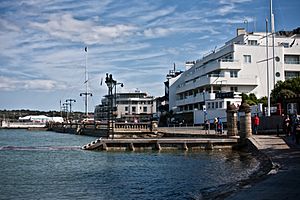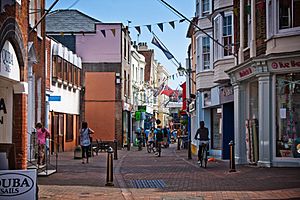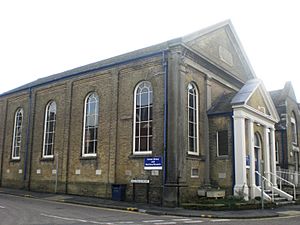Cowes facts for kids
Quick facts for kids Cowes |
|
|---|---|
 Cowes Parade |
|
| Area | 2.8 km2 (1.1 sq mi) |
| Population | 14,370 (2021 Census) |
| • Density | 5,132/km2 (13,290/sq mi) |
| OS grid reference | SZ493958 |
| Civil parish |
|
| Unitary authority | |
| Ceremonial county |
|
| Region | |
| Country | England |
| Sovereign state | United Kingdom |
| Post town | COWES |
| Postcode district | PO31 |
| Dialling code | 01983 |
| EU Parliament | South East England |
| UK Parliament |
|
Cowes is a busy seaport town in England, located on the Isle of Wight. It sits on the west side of the River Medina. Across the river is the smaller town of East Cowes. A special chain ferry called the Cowes Floating Bridge connects the two towns.
About 14,370 people lived in Cowes in 2021. Cowes is famous for yacht racing. The Royal Yacht Squadron was started here in 1815. It is home to Cowes Week, the world's oldest regular boat race, which happens every August. Later, exciting powerboat races are also held. Many buildings in Cowes show the fancy style that Prince Albert liked.
Contents
History of Cowes
How Cowes Got Its Name
The name Cowes comes from a long time ago. In 1413, two sandbanks on each side of the River Medina were called Westcowe. People thought they looked like cows. Later, King Henry VIII built forts on these banks to protect against French attacks. These forts were called "cowforts" or "cowes."
These forts gave their names to the towns of Cowes and East Cowes. Before this, the area was known as Shamblord. For a while, people argued if the town should be called Cowes or West Cowes. In 1895, it was officially named Cowes. Even today, some maps and ferry companies still use "West Cowes" for the town.
Early Days of Cowes
Centuries ago, Cowes and East Cowes were much smaller places. They were known as East and West Shamblord. The east side was more important back then.
The Isle of Wight was often a target for French invasions. So, forts were built in both settlements in the 1500s. The fort in Cowes, called Cowes Castle, still stands today. It looks different now, as its original towers are gone. The fort in East Cowes was destroyed long ago.
Cowes Becomes a Yachting Center
In 1589, a large ship called Rat O'Wight was built in Cowes for Queen Elizabeth I. This event helped Cowes become a famous place for building boats. But sailing for fun didn't become popular until much later.
When King George IV became king, he loved sailing. This helped Cowes become known as 'The Yachting Capital of the World'. In 1826, the Royal Yacht Squadron held a three-day boat race for the first time. The next year, the king gave a special cup for the event. This race became known as Cowes Regatta. It soon grew into a four-day event that always ended with fireworks.
Some famous clipper ships were built in Cowes, like the Nina (1852) and Eamont (1853).
World War II and the Blyskawica
During World War II, Cowes was attacked by air on May 4-5, 1942. Luckily, the Polish destroyer Blyskawica was there. This ship, built in East Cowes, bravely defended the town. In 2002, the crew's bravery was honored with a special event. In 2004, a part of Cowes was named Francki Place, after the ship's commander. There is also a Błyskawica Memorial in Cowes.
What Cowes is Known For
Cowes Economy and Jobs
For a long time, Cowes and East Cowes have been known for building and designing boats. This includes early flying boats and making sails. The first hovercraft was also tested here.
Today, big employers include BAE Systems Integrated System Technologies (Insyte) and GKN Aerospace in East Cowes. The town gets very busy during Cowes Week. This is the busiest time for local shops and restaurants.
Cowes has a lively high street with many shops. You can find special sailing shops, a small bookshop, and many other independent businesses. There are also cafes and restaurants to enjoy.
Sports and Fun in Cowes
Cowes has its own Non-League football club, Cowes Sports F.C.. They play their games at Westwood Park.
Getting Around Cowes

Cowes is an important entry point to the Isle of Wight. You can take a fast catamaran passenger ferry, called the Red Jet, from Cowes to Southampton.
Buses are a main way to get around. Southern Vectis' route 1 connects Cowes to Newport, where you can travel to other parts of the island. The Cowes Floating Bridge is a unique chain ferry that links Cowes and East Cowes all day long. It's one of the few chain ferries still in use.
The Isle of Wight Coastal Path starts in Cowes. This path lets you walk all around the island's coast. Cowes used to have a train line to Newport, but it was closed in 1966. Now, part of the old railway track is a cycle path.
Cowes Park and Ride
Cowes has a park and ride system. This means you can park your car on the edge of town and take a bus into the center. It has 85 parking spaces and a bus stop. Buses run every 10 minutes during the day. This system helps reduce traffic and parking problems in Cowes.
Famous People from Cowes
Many interesting people have lived in Cowes, including:
- Thomas Arnold — A famous headmaster of Rugby School.
- Uffa Fox — A well-known boat designer and sailor.
- Celia Imrie — An actress.
- Jeremy Irons — An Academy Award-winning actor.
- Ellen MacArthur — A famous solo long-distance sailor.
- Alan Titchmarsh — A popular gardener and TV presenter.
Sister Cities
Cowes has special connections with other towns around the world:
See also
 In Spanish: Cowes para niños
In Spanish: Cowes para niños








